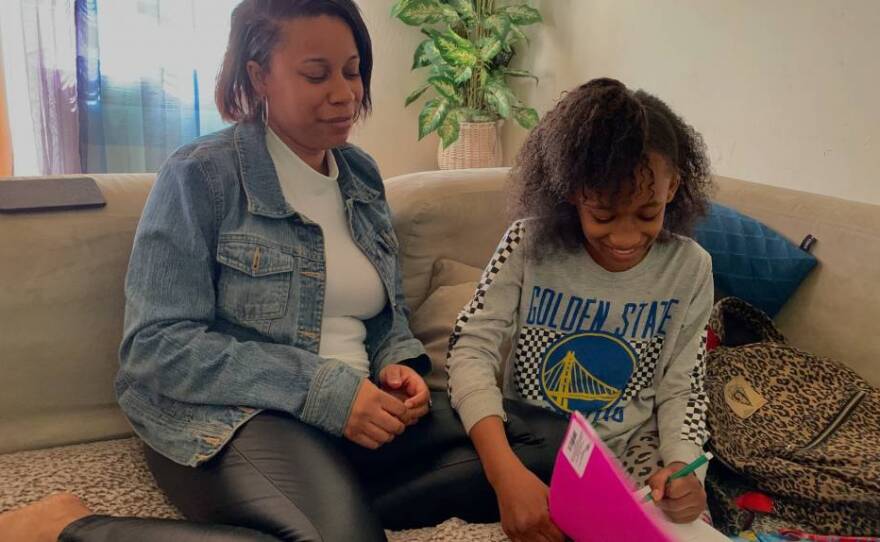Ta’Kira Dannette Byrd is thin and lithe, like a blade of wild grass swaying in the wind. The little girl was diagnosed with asthma when she was 5 years old. Her first major health crisis came three years later.
She remembers being “really really sick” all day. Then, in the middle of the night, her cat went bounding into mom’s room, yowling, and woke her up.
“I guess, like, my face was all purple and stuff and I couldn’t breathe,” said Ta’Kira, now 11.
Her mom, Shawntierra Dolton, came running into the living room, where Ta’Kira sleeps. She took one look at her daughter’s face and “hurried up and put the treatment on her.” Then they rushed to the hospital.
In the years that followed, the routine became an all-too-regular part of life for the Vallejo family. And the massive wildfires that burned every year almost certainly played a role.
Extreme fire seasons seem to be the new normal in the American West. The spate of lightning-sparked blazes that recently blanketed California in unhealthy smoke is just the most recent reminder.
But not everyone is affected equally. Just as we’ve seen with the coronavirus pandemic, place and race play a role.
Ta’Kira lives with her mom and two younger brothers at the Marina Vista Apartments — a low-income housing development comprised of blocky two-story buildings in downtown Vallejo. According to the California Healthy Places Index, developed by the Public Health Alliance of Southern California, their neighborhood is one of the least healthy in the entire state.
Among the poor health outcomes: high asthma rates.
For Ta’Kira, living with a condition that regularly inflames her airways can be scary.
“When we have PE and I run a lot, it makes me feel kind of weak and stuff,” she said. “It feels like my lungs are just closing up.”
Still, Ta’Kira tends to put a positive spin on things — even during an emergency treatment of oxygen and helium that doctors administered during that first hospitalization, to open up her lungs. Known as Heliox, the treatment is reserved for the most serious cases.
“I was put on that for an hour,” she said in a playful sing-song, “and I couldn’t even talk because the thing was on my mouth and on my nose. It made me sound like a squeaky mouse.”
Days later, Ta’Kira went home with a bunch of new prescriptions. But her medical records, which Shawntierra shared with KQED, reveal that she ran out of some key maintenance meds over the next few years — partly because of hitches with her Medi-Cal, the state’s government insurance program that serves low-income families.
Those hardships are just one example of how wealth can impact health — gaps in Ta’Kira’s treatment made controlling her asthma harder, and she landed back in the ER again and again. Then wildfires — record-breaking in their scope and devastation — started burning, beginning with the Tubbs Fire in October 2017.
The blaze raged through Sonoma and Napa counties, destroying several Santa Rosa neighborhoods. Even though it burned a ways from Vallejo, wildfires produce tiny particulate matter that can travel great distances and lodge deep in the lungs.
In the year that followed, Ta’Kira was rushed to the ER with bad asthma attacks every three to four months. But those visits didn’t happen on the days when the smoke was at its worst, though she felt it in her chest. Instead, Ta’Kira ended up visiting the ER repeatedly in the weeks and months that followed.
Dr. John Balmes, a professor of medicine and environmental health sciences at UCSF and UC Berkeley who studies the impact of air pollution on kids, said that’s not surprising.
“Based on what we know from outdoor air pollution and about asthma biology in general, the effects can be cumulative,” Balmes said.
The short-term impacts of wildfire smoke are well documented. Studies have shown that smoky days correlate with spikes in ER visits for lung and heart problems in real time.
As for long-term health effects, there’s a lot we still don’t know. A recent Stanford University study showed potentially lasting damage to the immune systems of kids who’d been exposed to fire smoke. And an investigation by the Center for Investigative Reporting found a spike in ER visits of adults and kids experiencing lung and heart ailments three to five months after the Tubbs Fire.
So, like with daily air pollution, Balmes said, it’s pretty clear that inhalation of particulate matter from smoke can cause harm over time.
“A child could be exposed to wildfire smoke for a period and have some increase in airway inflammation,” he said, “which would then put them at greater risk of exacerbations from allergens that they’re sensitized to, or make them more at risk for having exacerbation when they get a cold.”
New record-setting blazes would follow the Tubbs Fire. In November 2018, the Camp Fire decimated the town of Paradise in Butte County, spreading smoke laden with toxins from burning plastics and other industrial materials for hundreds of miles. Three months later, Ta’Kira was back in the hospital again. “Working very hard to breathe,” her medical notes say. “Unable to hold a long conversation.”
“I was scared because I had to get an IV,” she said. “They always put it in the same arm. But then this one nurse she knew I was scared so she took her time putting the fluid all the way in.”
Ta’Kira put on a brave face about that IV, and about the ambulance ride she took hours later, when she was transferred to the pediatric ICU in Oakland.
Her mom, Shawntierra, is a singer. And Ta’Kira says during that time in ICU, she often sang — especially during her long overnight stays on a pull-out couch next to her daughter’s bed.
For Shawntierra, these hospitalizations have been terrifying.
“I just remember crying a lot,” she said, “because they kept coming in the room doing extra stuff to her.”
Ta’Kira is not alone in her medical struggles. Black children like her are disproportionately affected by asthma, more likely to be hospitalized for it, and even to die from it. Especially in low-income neighborhoods like the Vallejo census tract where Ta’Kira has lived for her entire young life. Data show that more Black people live in that neighborhood than anywhere else in Vallejo.
Those concerning asthma statistics for Black children, Balmes said, are due in part to higher exposure to air pollution in low-income neighborhoods from sources such as industry and freeway soot. But also, he said, because of more indirect factors including discrimination, poor housing, poverty, noise and garbage
Given what we know about those trends, he said, wildfire smoke is “likely to differentially impact kids in these neighborhoods.”
During every wildfire-related smoke event, Ta’Kira’s mom said, she has made sure to follow public health advice to keep the ground-floor apartment’s windows and doors closed. But that only helps if they keep the smoke out.
Marina Vista’s oldest apartment buildings were built about 50 years ago. And about half a dozen residents — including Shawntierra — said smoke comes right in through the flimsy aluminum window frames.
Garbage is a problem at Marina Vista, too. It attracts critters whose droppings are common asthma triggers. Large, bulky, open-topped garbage bins sit just feet from Shawntierra’s unit, across a narrow pathway.
Shawntierra said management should move them farther away from the living units, “or at least spray more often for roaches and mice. Sometimes we’ll see them all outside the apartments and inside. Just everywhere.”
Last October, Ta’Kira was back at the ER again, on a cardiac monitor, getting a continuous flow of asthma meds through a nebulizer. Her lungs were already compromised when, a week later, the Kincade Fire started burning within 100 miles of her home, blanketing Vallejo in smoke. Two weeks later, she was back at the ER.
This year has been a bit better for Ta’Kira when it comes to asthma attacks, her mother said. Maybe because she’s getting older. Maybe because the medicines she takes each day are doing their job.
But last month’s lightning-triggered blazes bumped California into yet another unprecedented crisis: A record-breaking number of “Spare the Air” days led millions of residents — at least, those who were able — to take shelter indoors.
About a week into those bad-air days, I went back to Marina Gardens to visit Shawntierra and Ta’Kira. Even though Ta’Kira had only been to the ER once in the past few months, mom said she was “very, very worried” about the relentless smoke.
To be cautious, she and the kids had been taking refuge at Shawntierra’s mom’s home in Contra Costa County. Even though outside air quality there has been lousy, too, her place has higher-quality windows and doors.
“She lives in a two-story so it’s a lot more space for her,” Shawntierra said, “and when you enter in her house it’s just pure, clean. Clean air.”
Asthma has been a part of Ta’Kira’s life for years now. Inhaling tiny harmful particulate matter from wildfire smoke — that’s just one of her many triggers. But it’s joined the list of forces outside her control that cause her anxiety.
“I worry about fires a lot,” she said.
Ta’Kira was quiet on that last visit, saying she felt “fine.” But a few minutes later, Shawntierra called with an update: Ta’Kira, she said, had just told her that her chest had been hurting at night. She’d been keeping it to herself, because she was worried about going back to the hospital.







